ByAvi 2024-5-9 19:38:12 Author: checkmarx.com(查看原文) 阅读量:5 收藏
-
 By
Avi Hein
By
Avi Hein
- mins read 7:38

Modern applications commonly include not just original source code written by the developers who create the applications, but also code borrowed from a variety of third-party projects. If you want to ensure that your apps are free from security vulnerabilities linked to open source code – not to mention potential open source licensing violations – you need to be able to identify all of the software components that exist within it.
That’s where Software Composition Analysis, or SCA, comes in. By systematically scanning applications to detect open source code and other third-party resources that may exist in the application codebases, SCA helps businesses stay ahead of both security risks and licensing compliance challenges.
Keep reading for a detailed explanation of how Software Composition Analysis works, why it’s important, and how to add it to your business’s software security and compliance strategy
WHAT IS SOFTWARE COMPOSITION ANALYSIS?
Software Composition Analysis is the scanning of application source code or binaries to identify third-party components and dependencies. The purpose of SCA is to determine whether an application contains any code or dependencies that were sourced from external projects but have not been properly secured or licensed.
Importantly, SCA doesn’t address all facets of security. It won’t tell you whether any code your developers wrote themselves may be subject to SQL injection attacks, for example. But it will tell you if your developers have leveraged any third-party components in ways that expose your application and your business to risks.
THE IMPORTANCE OF SCA SCANS
To explain why SCA scans are important, let’s first discuss the way in which many modern applications are built.
In most cases, developers write a substantial amount of the code that exists inside an application. However, they also often borrow preexisting code from external sources – such as code from open source projects, which is freely available on sites like GitHub, and which can be legally integrated into new applications in most cases. In addition, developers might define dependencies for their applications that require the apps to import or install third-party modules or libraries when they run.
In general, there is nothing wrong with including third-party components or dependencies in an application. On the contrary, borrowing third-party resources is a smart way to speed up development because it reduces the amount of code that developers have to write themselves.
However, relying on third-party code or dependencies when building an application can expose apps to certain risks that would not exist if developers developed an entire codebase from scratch. The main risks include:
- Security vulnerabilities: Security vulnerabilities that affect any third-party code included in an application could be exploited by threat actors to compromise the application.
- Licensing risks: In some cases, licenses impose specific requirements on how code can be reused. For example, many open source licenses require developers who borrow open source code to make their own applications (or at least the parts of them based on open source code) open source, too.
If your developers systematically keep track of which third-party components they include in applications, managing security vulnerabilities and licensing requirements related to the components is easy. The problem that many organizations face, however, is that developers may forget to note when they leverage third-party components. They can copy-and-paste open source code into their codebase, for example, without documenting where they obtained the code or which licensing rules govern it.
In addition, the use of AI-assisted coding tools, such as GitHub Copilot, creates new challenges related to third-party code reuse. In rare cases, these tools have reportedly reproduced verbatim copies of open source code. This is another way by which third-party components could sneak into a codebase without developers realizing it.
This brings us to why SCA is important: It helps developers find any third-party components that they’ve inadvertently included in an application. With that insight – as well as information provided by other types of security testing methods that complement SCA, like DAST and SAST – they can make sure they are properly managing security and licensing needs related to all of the components inside the app.
SCA works in a straightforward way: Engineers deploy SCA tools that automatically scan applications and check whether any of the contents within them match or closely resemble known third-party components.
SCA tools can scan source code, which is the most reliable way of checking which third-party software resources may exist inside an app. However, some SCA scanners can also scan binaries, such as application executables and container images, to look for binary code that is similar to components known to have originated elsewhere.
Advanced SCA tools also provide additional critical features, such as automated recommendations about how to fix vulnerable components.
HOW TO USE SOFTWARE COMPOSITION ANALYSIS
In most cases, taking advantage of Software Composition Analysis is as simple as integrating an SCA tool, like Checkmarx SCA, into your CI/CD processes.
Checkmarx SCA automatically scans applications to compile a comprehensive inventory of their components. Going further, Checkmarx detects and evaluates risks associated with those components so that developers and security teams can take action by remediating vulnerabilities or addressing licensing compliance issues.
In a perfect world, developers would always keep track of which third-party components they introduce to apps. But in the real world, even the most seasoned developers make mistakes and oversights – which is why scanning applications provides a crucial second layer of defense against security and compliance risks.
Learn more about how Checkmarx helps businesses get the most from SCA by downloading the Checkmarx SCA data sheet and checking out this case study about how an eCommerce business upped its security game with help from SCA.
如有侵权请联系:admin#unsafe.sh